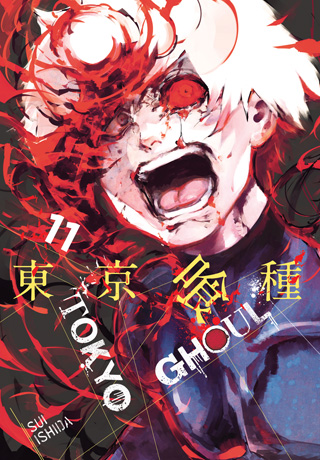In Tokyo Ghoul volume 11, Kaneki succumbs to the dark allure of his ghoul nature and not only nearly crushes the life out of Investigator Yukinori Shinohara, he also impales one of his friends with his bare hand. The commentators of this fictional Tokyo could excuse Kaneki’s moral alchemy due to the Gotham City-like museum of banal horrors that is Sui Ishida’s Tokyo. But we learned in volume 10 that Kaneki is not a product of his environment at all; he is an abomination by design, and this realization may have precipitated the dark descent that you would have expected a sudden hunger for human flesh to cause much sooner than this.
But after Kaneki discovers last volume that he is Dr. Kano’s ghoul/human patchwork, Kaneki tips full speed into ultraviolence worthy of Alex in A Clockwork Orange. There were intimations of this in earlier volumes, although Kaneki feigned reluctance to unleash his hidden hybrid powers; this reluctance was a necessity, as the vestige of his human drives was based in this denial of the reality of his current situation. Now the reluctance has been replaced by indifference, and while most of Tokyo Ghoul has concerned the angst of Kaneki’s physical transformation–which, at times, has almost been a second puberty, more inconvenient and humorous than horrific–for the past few volumes, we have watched Kaneki’s trip become a mind-altering one. Long gone are the days of him becoming acclimated to a diet of corpse lunch meat and coffee. Now he breaks the mold of his timid college freshman persona and takes on a villainous cast, so that when his mask comes off, the still face beneath seems more that of a ghoul than a human.
To be fair to both ghouls and villains, Kaneki is more like Harvey Dent than Alex, as we see in this volume that he still has a strong foundation of good bonded to his malefic flip side, and this good side does finally land face up later in this volume, during an outing to an author’s signing in Chapters 108 and 109, “Artificial,” and “Hanged Man.” The huge reveal at the end of chapter 109, and what it could mean to the Dr. Kano storyline, is something I would dearly like to talk about here–especially as it would dovetail nicely with my Two-Face, two sides of one coin, comparison–but I think this is a case of a surprise that each reader deserves to enjoy on their own.
In the last few volumes, the characters of Tokyo Ghoul seem to at last have caught up to the vision encoded in the setting–if it was a musical composition, the dueling motifs of the last several volumes would be sweeping underworld horror and the operatic ring of mad science–and the shadow wars of Tokyo Ghoul cry out for both a Burtonesque live action movie adaptation and a video game directed by the zombie of Bruegel the Elder.
Sui Ishida, a master mangaka, may have had my attention mainly on the storytelling during the last few volumes, but his art also remains stellar, with a quick line that cuts and creeps to parallel with the dialogue; most importantly, Ishida’s characters have body language, so that a look or a stance will tell you more than the dialogue. While I also enjoy series in which an artist / writer team have rapport–Food Wars, The Unbeatable Squirrel Girl, Slott and Allred’s Silver Surfer come to mind–it is to Ishida’s advantage that he directs his own hand, and not another’s. While I can’t really call Ishida’s art understated, there are no redundancies or unnecessary dialogue here.
Tokyo Ghoul Volume 11 is strongly recommended. It arrived on shelves February, 2017, but if you find it sold out, you can order it through the Viz Media website.
Viz Media sent the review copy.



Comments are closed.